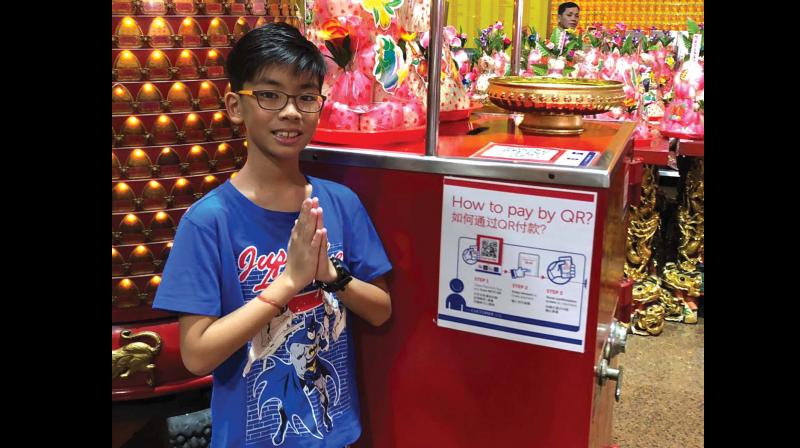Eat, pray and move digitally

Singapore is much more than the Merlion, the Marina Bay Sands and the ever-popular Mustafa, a favourite of the visiting Indian tourist.
A whistle-stop halt at the island-nation last fortnight was an eye opener about the digital ground covered by Lee Kuan Yew’s country in the last four years or so. While the must-see tourist attractions continue to draw people, a round of the heartlands indicated a silent tech and E-vehicle revolution of sorts.
Near Khatib, a predominantly Chinese part of the country, I chanced upon 11-year-old Cherwey praying at the local Soon Say Keng Tao temple. Taoism strikes a chord, with its rites, especially to someone from India.
I watched him light a pair of incense sticks, wave them reverentially before the idols, join his hands in a “namaste” and say his prayers during the traditional Ghost Festival which falls in the 7th month of the Chinese Lunar Year.
That the Vaavu Bali in Kerala falls in the same month appeared to me more than just a coincidence.
Be that as it may it was what little Cherwey did next that was incredible, for a visitor like me, back in Singapore, after about 5 years.
Quite instinctively, he flashed his mobile (“handphone” to Singaporeans) on to the QR code on the donation box (our “kaanikka vanchi”) to offer his 5 dollars to the temple’s collection.
The 5th Standard boy’s action exemplifies the new Singapore which is moving all transactions on to the digital platform so fast that not only is cash disappearing fast,even plastic cards, whether debit or credit, are making their exit.
The Taoist temple now gets most of its donations digitally as also a wayside restaurant nearby.
Like the small tea shops we have, the place is distinguished only by its cleanliness.
Otherwise the settings and the clientele are akin to the eateries we have in our countrysides.
I sat down with my friend, a Singapore national and no waiter came up to me. I was amused. For the Singapore that I lived in for four years was known for its prompt and speedy customer service. But my friend clarified the current procedure.
You have to just scan the QR code stuck on the table and the menu card appears on the phone. Choose whatever items you want and place the order through the phone. Your credit card or debit card, which is in the form of an e-wallet on your phone, debits your account.
The order goes to the kitchen automatically and the waiter brings the food. “Soon, even the serving of the food will be done by robots, Sir,” the owner, a young Chinese in her thirties, gleefully said.
Outside, on the streets, electric vehicles dot the landscape with men and women, on errands and outings, buzzing by. While our Prime Minister Modi’s FAME scheme (Faster Adoption and Manufacture of E-vehicles) is being debated, Singaporeans have taken to E-vehicles in a big way. In the small nation of about 6 million people, nearly 75,000 E-vehicles were sold in June alone.
A dealer for e-vehicles tells me the demand is so huge that the government has made registration compulsory for even E-cycles now. The cost is about Singapore Dollars 300 (Rs 15,000) and it makes for smart local mobility — to the market, the neighbourhood eatery or the visit to a friend’s place.
Under its “Smart Nation” mission — similar to Modi’s Digital India — Singapore seems to have changed the way ordinary people transact their business.
Says Mohammed Salim, a Singaporean national of Indian origin, who works for a bank, “I do all of my transactions through the mobile phone nowadays. I don’t have to remember to carry cash or even my credit or ATM cards because the handphone is my payment gateway.”
These changes have been driven by the government’s initiative called “Infocomm Media 2025” which aims at “driving economic success, empower and ease everyday life, connect people and make Singapore continue to be a successful nation”.
Developed by the Ministry of Communi-cations and Information, this 10-year plan released in August 2015, consists of three strategic thrusts:
“Build on the power of data and data insights, advanced communications and computational technologies to catalyse transformation across key sectors of our economy.
“Develop a future-ready workforce that embraces risk-taking and innovation.
“Deploy infocomm media technologies in a people-centric manner.
The E-vehicle foray is not part of this mission but in terms of the approach of the people, the electric bike or cycle jells with a lifestyle which is becoming more and more tech-based.
In a latest, Singapore is now actively studying whether to allow companies with no banking parentage to set up “virtual” banks.
“Some other countries have created frameworks to license new players with no banking parentage to set up digital banks, i.e. banks without branches or ATMs,” Singapore Prime Minister Lee Hsien Loong said in a speech at the Smart Nation Summit last month.
“The Monetary Authority of Singapore is now actively studying whether to allow this in Singapore,” he said
People are signing up to volunteer as Smart Nation ambassadors to make people tech-savvy and use digital modes in their day-to-day lives.
It is here that Prime Minister Modi’s Digital India rings a bell. While tiny nations like Singapore are turning smarter, can India be far behind?
Digital seems undoubtedly to be the way forward in day-to-day transactions in India as well though Rural India will take some time in catching up.
(S. Adikesavan, a senior banker who has worked in Singapore, was on a visit recently)

